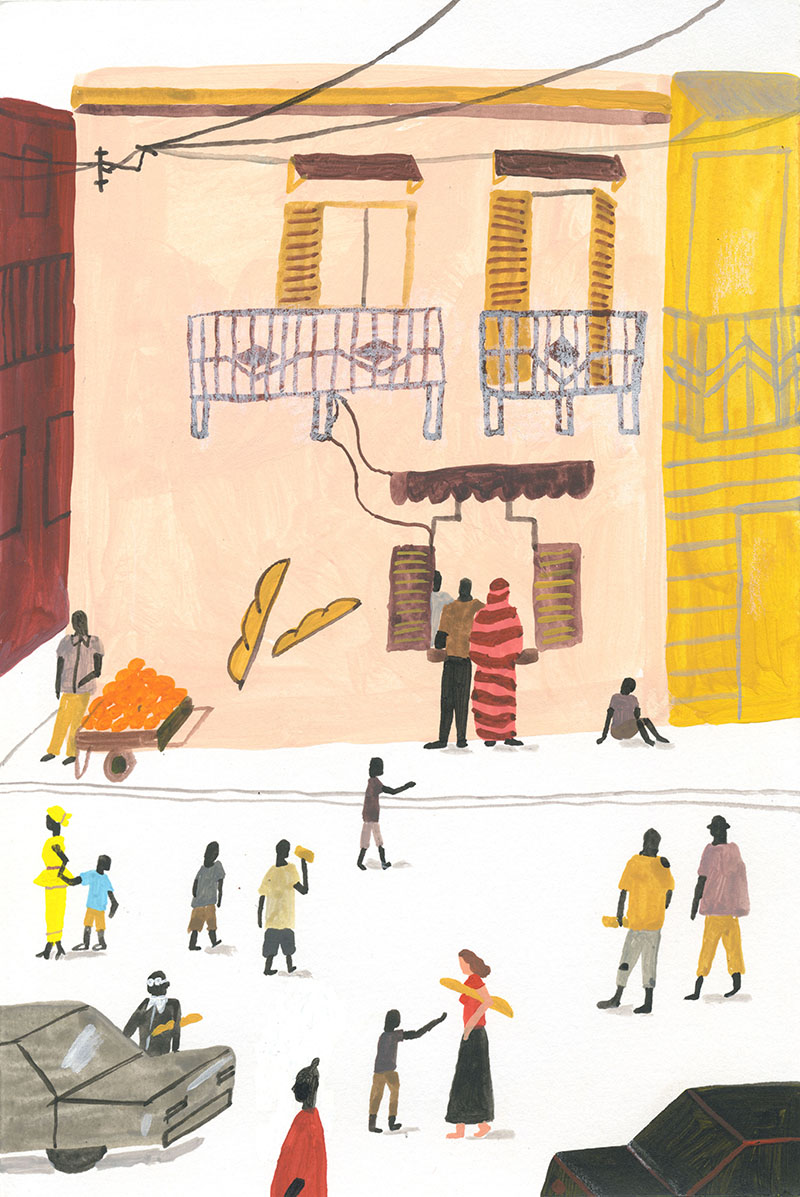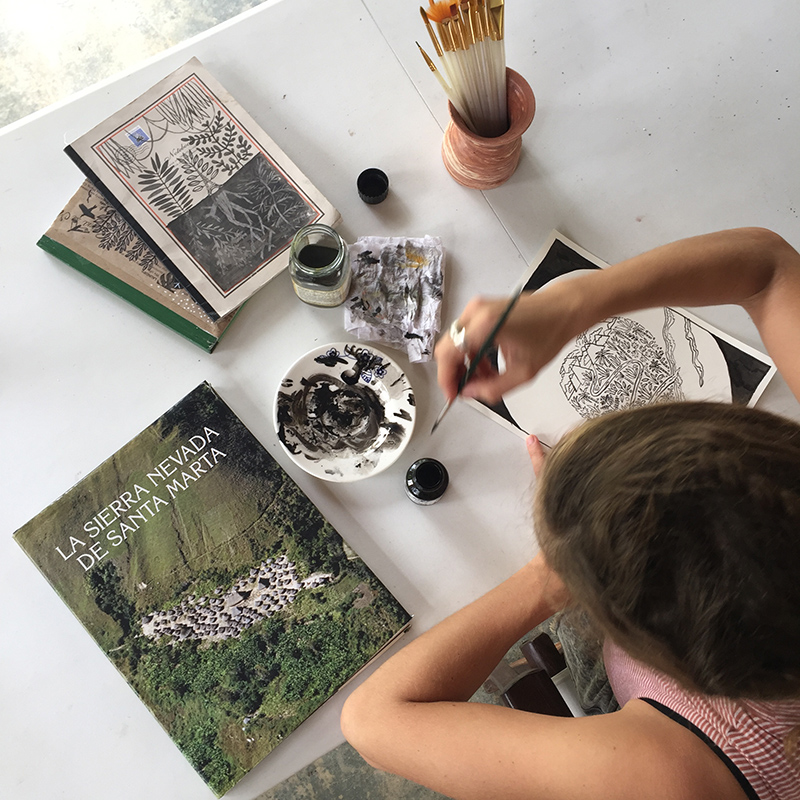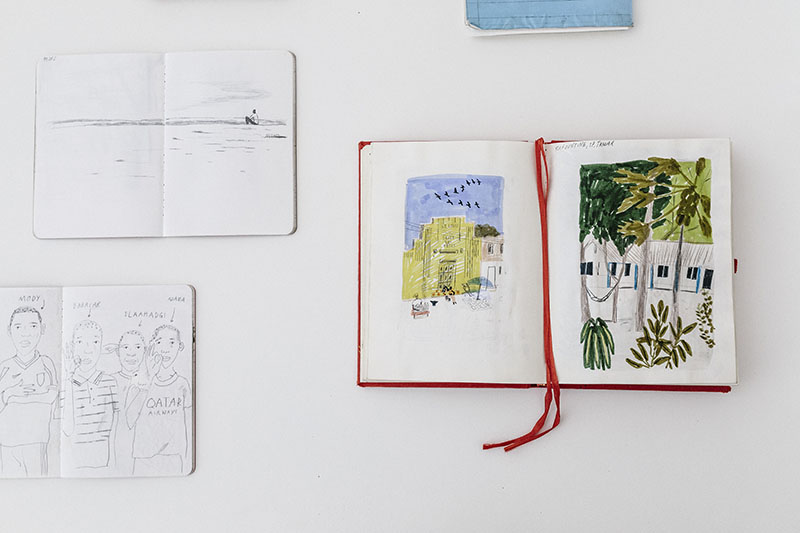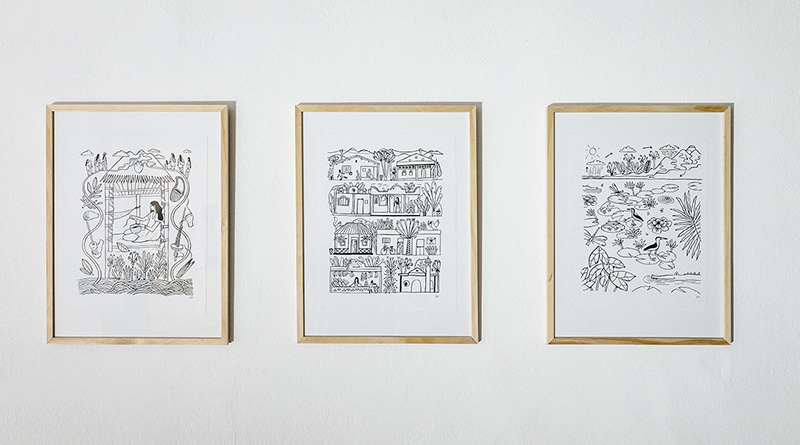Contemporary artist Isabel Peterhans thinks of her drawing hand as a separate, autonomous creative spirit, with an uncontrollable access to a creative cosmos.
I am fascinated by the inexplicable and the unpredictable.

Frauen.
How do you describe yourself in the context of challenging people’s perspectives via your work and art?
I am a very curious person and I love getting to know new things. As soon as I dive deep into a topic I get very excited about it.
I am fascinated by the inexplicable and the unpredictable. With my art work I have to surprise myself eventually, otherwise I lose interest in it. As if my drawing hand were a separate being, with an uncontrollable access to an artistic, creative cosmos.
Ideas are not the problem, I have plenty of them. My biggest challenge is to filter them.
How do you deal with the conceptual difficulty and uncertainty of creating new work?
Ideas are not the problem, I have plenty of them. My biggest challenge is to filter them. Which ideas can I implement fastest and best at a certain moment? Which ones do I have time for? Which ones are of general interest? I am still struggling with that and often work on many projects at once.

Depot.
Tell us about the evolution of your practice over the years. What would you call your style?
Stylistically, I have never really committed myself, and I am always trying out new techniques. An 80 year old artist from the region (Ilse Prandstetter) once said in an interview that she doesn’t want to be skilful in anything, she just wants to learn. I thought that was very much to the point, I also concentrate on discovering and learning.
Drawn reportages are documentary reports that are obviously subjective, since a drawing is automatically a subjective representation of the drawer. I worked in Haiti, Italy and in the refugee camps at the European borders.
What also influenced me was drawing on the road, which began with my diploma work and published book “Yallabyebye”, wherein I made drawings based on my experiences during my exchange semester in Israel.
Later, I continued to work a lot on the road, in sketchbooks and made drawn reportages. Drawn reportages are documentary reports that are obviously subjective, since a drawing is automatically a subjective representation of the drawer. I worked in Haiti, Italy and in the refugee camps at the European borders.
Today I draw more often in my studio, but my sketchbooks remain the core of my work. The sketchbooks are something like an advanced memory, because I am extremely forgetful. This forgetfulness also shapes my naive style, as I always forget how something is drawn correctly. So I intuitively draw it, just as it comes to me.

Nokobok.
There was a small library near my studio, where I found oracle cards. In desperation, I drew one in the hope that it could help me, even though it seemed a bit ridiculous. The card I drew advised me to, ‘Forget everything and go swimming in the ocean’.
So I that is what I did, because I didn’t know what else to do with myself. And when I left the water, I suddenly knew exactly how everything should be. I realised the importance of breaks and coincidences for my work.
What were the biggest learnings and hiccups in your artistic journey?
Blockages used to throw me completely off track. I was in Colombia, in a beautiful artists’ residence, where I had started working on a painting book, when I got stuck again and panicked.
There was a small library near my studio, where I found oracle cards. In desperation, I drew one in the hope that it could help me, even though it seemed a bit ridiculous. The card I drew advised me to, ‘Forget everything and go swimming in the ocean’.
So I that is what I did, because I didn’t know what else to do with myself. And when I left the water, I suddenly knew exactly how everything should be. I realised the importance of breaks and coincidences for my work.

Image credit Marta Banick.
Together with my boyfriend I founded an online Solidarity Shop, which helps us get along and we donate half of our earnings to the refugees in the Greek refugee camps.
What are you working on during this lockdown? How are you balancing life and work at home during the lockdown?
I became a mom in 2019. Therefore, I wound down my independent activity about a year ago. The few jobs I had came to a standstill, because of the lockdown and suddenly, I had no more work. I felt paralysed and wanted to become active. So, together with my boyfriend I founded an online Solidarity Shop, which helps us get along and we donate half of our earnings to the refugees in the Greek refugee camps.

Image credit Thomas Schrott.
I like courageous art or art that arises from a pure necessity of the artist, like Art Brut; art from closed institutions, produced by inmates, intuitively, delusional, incessantly, always the same patterns, sayings, figures in thousands of variations, honest, without aiming at pleasing an audience or only wanting to satisfy the art industry.
What do you look for while viewing art? Which shows, performances and experiences have shaped your own creative process? Who are your maestros?
I appreciate art which is not too spiritual, that allows an emotional approach. I like courageous art or art that arises from a pure necessity of the artist, like Art Brut; art from closed institutions, produced by inmates, intuitively, delusional, incessantly, always the same patterns, sayings, figures in thousands of variations, honest, without aiming at pleasing an audience or only wanting to satisfy the art industry.
I don’t like the expression naïve art, because it sounds pejorative. A book that I own, The Art of the Naive (1975), summaries the areas of art of indigenous peoples, children’s art, pictures of mentally ill people (Art Brut) and folk art. These are all constant sources of inspiration for me.
I also like photographic work very much. Photographers who manage to capture the poetry of our monotonous, sometimes painful everyday life and show us its beauty, such as Diane Airbus, Graciela Iturbide and Viviane Mayer.
My idol is perhaps my grandmother, who has already passed away, unfortunately. Her infinite creativity flowed into all areas of her daily life, because she never had the opportunity to work in a creative profession like me.
How do you strike a balance between the contradicting motivations; commercial v/s creative?
In my free works I try out, play around and learn to let things happen. When I have an assignment, everything has to work and be finished by a deadline. That’s a change you have to get used to. It then feels to me like I’m performing, applying what I’ve learned. After that I go back to the learning and playing phase.

Image credit Thomas Schrott.
What was your first sale? Do you handle the commercials yourself or is it outsourced to a gallery/agent?
When I was a child I sold my drawings on the street, together with picked bunches of flowers. To this day, I have been selling my work entirely by myself.
Tell us about your studio, what kind of place is it? Could you describe your usual work-day in the studio?
I share my studio with my boyfriend, but we are almost never there together, because we share the task of caring for our daughter 50/50, which is an incredible privilege.
I start with warm-up drawings and if I have time I work on free projects afterwards. After lunch is the latest when I start working on assignments and when I get tired, or don’t know how to continue, I do prints of teapots.
For enquiries contact: mail@isabelpeterhans.ch
Before you go – you might like to browse our Artist Interviews. Interviews of artists and outliers on how to be an artist. Contemporary artists on the source of their creative inspiration.












Add Comment